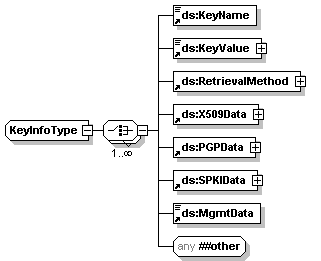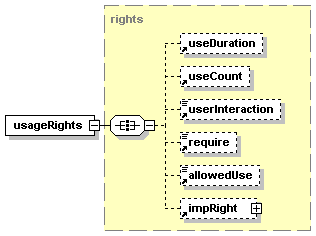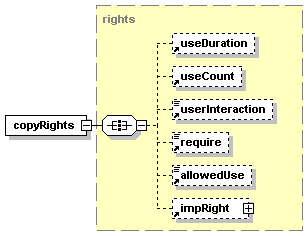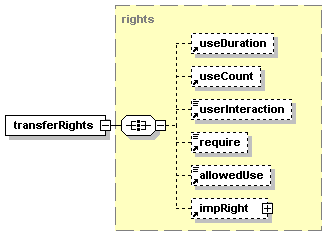This document specifies XMCL, the eXtensible Media Commerce Language. The language
is an interchange format that describes usage rules that apply to multi-media
content. It is designed to communicate these rules in an implementation independent
manner for interchange between business systems and DRM implementations responsible
for enforcing the rules described in the language.
Status of this document
This document is a submission to the World Wide Web Consortium from RealNetworks, Inc. for
consideration as a foundation for work on a rights description language.
(see Submission Request, W3C Staff Comment).
This draft is not complete, where elements or attributes are not fully
described, their intended use described as
a placeholder. Items in red are editorial notes for
the authors/contributors to consider while working on the document. They are not
meant to be part of the specification.
This document is a Note made available by W3C for discussion only. This
work does not imply endorsement by, or the consensus of the W3C membership,
nor that W3C has, is, or will be allocating any resources to the issues
addressed by the Note. This document is a work in progress and may be updated,
replaced, or rendered obsolete by other documents at any time. For a full list of
all acknowledged Submissions, please see
Acknowledged Submissions of W3C.
A list of current W3C technical documents can be found at the Technical Reports page.
1 Introduction
1.1 Conformance conventions
2 XMCL Overview and Examples
2.1 Rental Example
2.2 Ownership Example
3 Processing Rules
4 Core XMCL Syntax
4.1 The <xmcl> element
4.2 The <clientInfo> element
4.2.1 The <param> element
4.3 The <license> element
4.3.1 The <contentInfo> element
4.3.1.1 The <contentID> element
4.3.1.2 The <ds:KeyInfo> element
4.3.1.3 The <key> element
4.3.1.4 The <validPeriod> element
4.3.2 The <usageRights> element
4.3.3 The <copyRights> element
4.3.4 The <transferRights> element
4.3.5 The Rights elements
4.3.5.1 The <useDuration> element
4.3.5.2 The <useCount> element
4.3.5.3 The <require> element
4.3.5.4 The <userInteraction> element
4.3.5.5 The <allowedUse> element
4.3.5.6 The <impRight> element
5 Extension Syntax
5.1 The <revocationList> element
5.1.1 The <revokedItem> element
5.1.2 The <auth> element
6 Definitions
Business system
Trusted system
License
7 References
This document specifies the Syntax and Semantics of XMCL, an
eXtensible Media Commerce Language. Digital media in a rights
management system flows through a number of steps on its journey to
a consumer's eyes and ears. The steps are: create, package,
publish, distribute, license, and consume. At least a subset
of these abstract steps is implemented by all rights management
systems today. The service or business owner that manages one
or more of these steps varies widely depending on the relationships
negotiated for a specific piece of content. However, there is
a natural break between the back-end systems for publishing and
licensing on one side and the trusted system that packaged the
content and enforces the business rules for the content on the
other. This division is between the systems that describe the
business rules for the content and the specific implementation that
enforces those rules.
XMCL is a "rights specification language", as defined by the
Association of American Publishers [DRMEBOOKS]. The
purpose of XMCL is for interchange of business rules to be applied
to media between business systems (e.g. web store fronts, customer
tracking and management) and trusted delivery and playback systems
(e.g. a DRM implementation that will enforce the rights described
in the XMCL document). Through the use of XMCL business
systems are completely free of knowledge of specific trusted system
implementations. This separation of the business systems and
the trusted system allow businesses to support one or more trusted
systems and provides the option of changing trusted systems as
conditions change without changes to the business systems.
XMCL describes the minimum, self-complete set of business rules
under which digital media is licensed for consumer use. These
business rules support multiple business models including rental,
subscription, ownership, and video on demand/pay-per-view.
When a business system authorizes a customer transaction for
digital media, it generates a XMCL document that is then acted upon
and enforced by a specific trusted system. The generated XMCL
document is submitted to the trusted system through the APIs of the
trusted system (e.g. HTTP POST, RPC call, API call).
This document does not define interoperability end-to-end, but
takes an important first step in that direction. As noted in
the summary of the recent W3C Workshop on DRM, none of the
standards efforts they evaluated "[deal] with what we think of as
the essential first step for the Web: the simple expression and
communication of IPR information and policies." [WWWDRM].
The key words "MUST", "MUST NOT", "REQUIRED", "SHALL", "SHALL NOT", "SHOULD",
"SHOULD NOT", "RECOMMENDED", "MAY", and "OPTIONAL" in this specification are
to be interpreted as described in RFC2119 [KEYWORDS]:
"they MUST only be used where it is actually required for interoperation
or to limit behavior which has potential for causing harm (e.g., limiting
retransmissions)"
Consequently, we use these capitalized keywords to unambiguously specify requirements
over protocol and application features and behavior that affect the interoperability
and security of implementations. These key words are not used (capitalized)
to describe XML grammar; schema definitions[XSCHEMA-STRUCTURE]
unambiguously describe such requirements and we wish to reserve the prominence
of these terms for the natural language descriptions of protocols and features.
For instance, an XML attribute might be described as being "optional." Compliance
with the XML-namespace specification [XMLNAMES]
is described as "REQUIRED."
This section provides an overview and examples of XMCL for a few
common use cases. This section is informative. Refer to
Processing Rules (section 3) and Core XMCL Syntax (section 4) for
the normative definition of the language.
XMCL documents are intended to be the interchange that bridges
between a back end business system and a specific trusted
system.
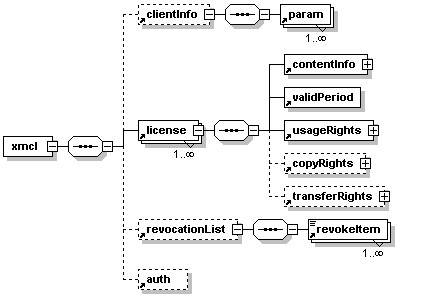
- <xmcl>
- <license>
- <contentInfo>
- <contentID type="GUID">
-
13AC7DE5-8028-42fe-95CE-0DC2221891C7
- </contentID>
- <ds:KeyInfo
-
xmlns:ds="http://www.w3.org/2000/09/xmldsig#">
-
<ds:KeyName>ContentKey</ds:KeyName>
-
<ds:KeyValue>
-
<key algorithm="urn:nist-gov:tripledes-ede-cbc">
-
3812A419C63BE771 AD9F61FEFA20CE63 3812A419C63BE771
-
</key>
-
</ds:KeyValue>
- </ds:KeyInfo>
- <rdf:RDF xmlns:rdf=
-
"http://www.w3.org/1999/02/22-rdf-syntax-ns#"
-
xmlns:dc="http://purl.org/dc/elements/1.1/">
-
<rdf:Description>
-
<dc:title>First Blood</dc:title>
-
<dc:subject>
-
movie, action, adventure
-
</dc:subject>
-
</rdf:Description>
- </rdf:RDF>
- </contentInfo>
- <validPeriod start="2001614T184300"
- end="2001621T184300"/>
- <usageRights>
- <useDuration length="24h" begin="firstUse"/>
- </usageRights>
- </license>
- </xmcl>
This XMCL document contains a single <license> element. The <contentID>
element on line 4 defines the unique identifier for the content. The type attribute
specifies that the id used is a GUID. The <ds:KeyInfo> element on line 7
specifies the symmetric key for decryption of the content. KeyInfo is borrowed
from [XMLDSIG]. Lines 16-25 describe meta information
that further defines the content using Dublin Core elements as defined in [DCMES-XML].
The <validPeriod> element on line 27 describes that the license is valid
from June 14, 2001 at 18:43 to June 21, 2001 at 18:43. The useDuration element
on line 30 says the content is licensed for 24 hours from first use.
The following is an example XMCL document describing an
ownership license for the song "Bang the Drum Slowly".
- <xmcl>
- <license>
- <contentInfo creatorId="Frank LeMedere"
- licensorID="Audiotrax">
- <contentID type="GUID">
- 13AC7DE5-2180-42fe-95CE-0D18028891C7
- </contentID>
- <ds:KeyInfo
- xmlns:ds="http://www.w3.org/2000/09/xmldsig#">
- <ds:KeyName>ContentKey</ds:KeyName>
- <ds:KeyValue>
- <key algorithm="urn:nist-gov:tripledes-ede-cbc">
- 3812A419C63BE771 AD9F61FEFA20CE63 3812A419C63BE771
- </key>
- </ds:KeyValue>
- </ds:KeyInfo>
- <rdf:RDF xmlns:rdf=
- "http://www.w3.org/1999/02/22-rdf-syntax-ns#"
- xmlns:dc="http://purl.org/dc/elements/1.1/">
- <rdf:Description>
- <dc:creator>Emmy Lou Harris</dc:creator>
- <dc:title>
- Bang The Drum Slowly
- </dc:title>
- <dc:date>2001</dc:date>
- </rdf:Description>
- </rdf:RDF>
- </contentInfo>
- <validPeriod start="2001614T184300" />
- <usageRights>
- <useDuration length="infinite"/>
- </usageRights>
- </license>
- </xmcl>
This XMCL document contains a single <license> element.
The <contentID> element on line 5 defines the unique identifier
for the content. The type attribute specifies that the id used is a GUID.
The <ds:KeyInfo> element on line 8 specifies the symmetric key for
decryption of the content. KeyInfo is borrowed from [XMLDSIG].
Lines 17-27 describe meta information that further defines the content
using Dublin Core elements as defined in [DCMES-XML].
The <validPeriod> element on line 29 describes that the license is valid
starting on June 14th, 2001 at 6:43 PM. The useDuration element
on line 31 says the content is licensed for an unlimited duration from issue.
This section is normative.
An implementation MUST parse, understand, and enforce a license
described using the core syntax. If an implementation cannot
understand or enforce any rules described in the license section,
it MUST return an error and fail to return a license.
An implementation MUST support at least one <license>
element per document. Support for multiple <license>
elements is OPTIONAL.
An implementation MUST support XML namespaces
[XMLNAMES]. Namespace extensions that are not recognized
MUST be ignored. If a license if valid without the namespace
qualified elements, it MUST be considered to be understood.
If a license is not valid when qualified elements are ignored, an
implementation MUST return an error and fail to return a
license.
The general structure of an XMCL document is described in the XMCL Overview (section
2). This section provides detailed syntax of the core XMCL features. Features
described in this section are mandatory to implement unless otherwise indicated.
The XML Schema definitions used are from [XSCHEMA-STRUCTURE]
The xmcl element is the outer structure element in the
language. There MUST be only one xmcl element per
document. It contains all of the licenses along with any
trusted system specific information required to generate or enforce
the license.
| diagram |
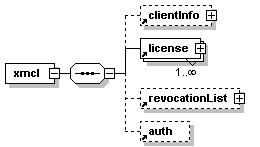 |
| namespace |
http://namespaces.xmcl.org/xmcl |
| children |
clientInfo license revocationList auth |
| source |
<xs:element name="xmcl">
<xs:complexType>
<xs:sequence>
<xs:element ref="clientInfo" minOccurs="0"/>
<xs:element ref="license" maxOccurs="unbounded"/>
<xs:element ref="revocationList" minOccurs="0"/>
<xs:element ref="auth" minOccurs="0"/>
</xs:sequence>
</xs:complexType>
</xs:element> |
The clientInfo element contains any parameters that are needed
by a specific trusted system to generate or enforce the license(s)
described by the <license> elements. There are no
defined attributes for this element at this time. Base XML
attributes defined in [XML] SHOULD be allowed. The
clientInfo element contains one or more <param> elements.
| diagram |
 |
| namespace |
http://namespaces.xmcl.org/xmcl |
| children |
param |
| used by |
|
| source |
<xs:element name="clientInfo">
<xs:complexType>
<xs:sequence>
<xs:element ref="param" maxOccurs="unbounded"/>
</xs:sequence>
</xs:complexType>
</xs:element> |
The param element is borrowed from [XHTML] XHTML 1.0 and is used to
define name value pairs to convey implement specific parameters to
the trusted system.
| diagram |
 |
| namespace |
http://namespaces.xmcl.org/xmcl |
| used by |
|
| attributes |
| Name | Type | Use | Default | Fixed | | id | xs:ID | | | | | name | xs:string | | | | | value | xs:string | | | | | valuetype | xs:NMTOKEN | | | | | type | xs:string | | | |
|
| source |
<xs:element name="param">
<xs:complexType>
<xs:attribute name="id" type="xs:ID"/>
<xs:attribute name="name" type="xs:string"/>
<xs:attribute name="value" type="xs:string"/>
<xs:attribute name="valuetype" type="xs:NMTOKEN"/>
<xs:attribute name="type" type="xs:string"/>
</xs:complexType>
</xs:element> |
The license element contains the business rules that the trusted
system should use to generate the implementation specific
license.
| diagram |
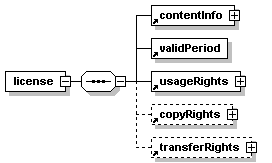 |
| namespace |
http://namespaces.xmcl.org/xmcl |
| children |
contentInfo validPeriod usageRights copyRights transferRights |
| used by |
|
| attributes |
| Name | Type | Use | Default | Fixed | | numCopies | xs:decimal | | | | | allowTransfer | xs:boolean | | | |
|
| source |
<xs:element name="license">
<xs:complexType>
<xs:sequence>
<xs:element ref="contentInfo"/>
<xs:element ref="validPeriod"/>
<xs:element ref="usageRights"/>
<xs:element ref="copyRights" minOccurs="0"/>
<xs:element ref="transferRights" minOccurs="0"/>
</xs:sequence>
<xs:attribute name="numCopies" type="xs:decimal"/>
<xs:attribute name="allowTransfer" type="xs:boolean"/>
</xs:complexType>
</xs:element> |
The contentInfo element identifies and contains information
specific to the piece of content being licensed.
| diagram |
 |
| namespace |
http://namespaces.xmcl.org/xmcl |
| children |
contentID key |
| used by |
|
| attributes |
| Name | Type | Use | Default | Fixed | | creatorID | xs:string | required | | | | licensorID | xs:string | required | | |
|
| source |
<xs:element name="contentInfo">
<xs:complexType>
<xs:sequence>
<xs:element ref="contentID" minOccurs="0"/>
<xs:element ref="key" minOccurs="0"/>
<xs:any namespace="dublin core meta element" minOccurs="0" maxOccurs="unbounded"/>
</xs:sequence>
<xs:attribute name="creatorID" type="xs:string" use="required"/>
<xs:attribute name="licensorID" type="xs:string" use="required"/>
</xs:complexType>
</xs:element> |
Contains an identifier for the content. It contains no
other elements. The type attribute specifies the type of data
contained by the element.
| diagram |
 |
| namespace |
http://namespaces.xmcl.org/xmcl |
| type |
xs:string |
| used by |
|
| source |
<xs:element name="contentID" type="xs:string"/> |
This element is taken from XML Digital Signatures [XMLDSIG] and
is used to communicate cryptographic keys from system to
system. See XML Digital Signatures [XMLDSIG] for further
explanation of the elements semantics.
This spec extends the <ds:KeyValue> [XMLDSIG] element with
the key element. The key element opens the algorithm list by
providing a container for the key data and the algorithm attribute
to identify the algorithm. The algorithm attribute uses the
algorithm URI's from XML Encryption [ALGORITHMS].
| diagram |
 |
| namespace |
http://namespaces.xmcl.org/xmcl |
| type |
xs:string |
| used by |
|
| source |
<xs:element name="key" type="xs:string"/> |
The validPeriod element describes the dates during which the
license is valid. It takes a start and end attribute.
The start and end attributes define the calendar dates and times in
the format described in [XSCHEMA-DATATYPES]. The enforcement
system should only honor the rights expressed in the license after
the date-time specified with the start attribute and until the date
specified in the end attribute.
| diagram |
 |
| namespace |
http://namespaces.xmcl.org/xmcl |
| used by |
|
| attributes |
| Name | Type | Use | Default | Fixed | | start | xs:dateTime | required | | | | end | xs:dateTime | required | | |
|
| source |
<xs:element name="validPeriod">
<xs:complexType>
<xs:attribute name="start" type="xs:dateTime" use="required"/>
<xs:attribute name="end" type="xs:dateTime" use="required"/>
</xs:complexType>
</xs:element> |
The usageRights element describes the rights that are granted in
the license.
The copyRights element describes the rights that are granted in
the copy license. If the element is empty, all the rights
described in the <usageRights> are copied.
The transferRights element describes the rights that are granted
in the transfer license. If the element is empty, all the
rights described in the <usageRights> are transferred.
The following elements are used to specify rights in the
<usageRights>, <copyRights>, and <transferRights>
elements. They describe the interoperable right set as well
as a generic right element, <impRight>, that can be used to
describe rights specific to a particular implementation.
| diagram |
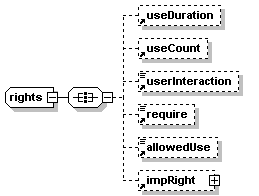 |
| namespace |
http://namespaces.xmcl.org/xmcl |
| children |
useDuration useCount userInteraction require allowedUse impRight |
| used by |
|
| source |
<xs:complexType name="rights">
<xs:all>
<xs:element ref="useDuration" minOccurs="0"/>
<xs:element ref="useCount" minOccurs="0"/>
<xs:element ref="userInteraction" minOccurs="0"/>
<xs:element ref="require" minOccurs="0"/>
<xs:element ref="allowedUse" minOccurs="0"/>
<xs:element ref="impRight" minOccurs="0"/>
</xs:all>
</xs:complexType> |
The useDuration element specifies a length of time the content
can be used after a specific event. The begin attribute
specifies when the duration should begin. Its values are
"issue" and "firstUse". The "issue" value specifies the
duration starts at the issue of the license. The "firstUse"
value specifies the duration starts when the content is first
used. The length attribute specifies the length of time.
| diagram |
 |
| namespace |
http://namespaces.xmcl.org/xmcl |
| used by |
|
| attributes |
| Name | Type | Use | Default | Fixed | | begin | xs:NMTOKEN | | | | | length | xs:duration | required | | |
|
| source |
<xs:element name="useDuration">
<xs:complexType>
<xs:attribute name="begin" type="xs:NMTOKEN"/>
<xs:attribute name="length" type="xs:duration" use="required"/>
</xs:complexType>
</xs:element> |
The useCount element specifies the number of times the content
can be used. It takes the count attribute and the threshold
attribute.
| diagram |
 |
| namespace |
http://namespaces.xmcl.org/xmcl |
| used by |
|
| attributes |
| Name | Type | Use | Default | Fixed | | count | xs:integer | required | | | | threshold | xs:duration | optional | | |
|
| source |
<xs:element name="useCount">
<xs:complexType>
<xs:attribute name="count" type="xs:integer" use="required"/>
<xs:attribute name="threshold" type="xs:duration" use="optional"/>
</xs:complexType>
</xs:element> |
The intent of the require element is to describe
conditions that the trusted system are to require for
playback. It should include things like employment water
marking technology, use of a specific decompressor implementation,
etc.
| diagram |
 |
| namespace |
http://namespaces.xmcl.org/xmcl |
| type |
xs:string |
| used by |
|
| source |
<xs:element name="require" type="xs:string"/> |
The intent of the userInteraction element is to
describe something that requires user interaction before use of the
licensed content will be allowed. This includes things like
accepting a "click-wrap" license agreement at each playback.
| diagram |
 |
| namespace |
http://namespaces.xmcl.org/xmcl |
| type |
xs:string |
| used by |
|
| source |
<xs:element name="userInteraction" type="xs:string"/> |
The intent of the allowedUse element is to
describe things like the content can only be included as a whole
vs. included in a larger work.
| diagram |
 |
| namespace |
http://namespaces.xmcl.org/xmcl |
| type |
xs:string |
| used by |
|
| source |
<xs:element name="allowedUse" type="xs:string"/> |
The impRight element is a generic extension mechanism that
allows inclusion of implementation specific rights in a
license. The implementation is identified by the
implementationID attribute as a URI [URI].
Ed Note: Should pull in <switch> element and
systemRequired element from SMIL 2.0 for this section so a XMCL doc
could describe implementation specific rights for multiple
implementations and the parsing application could correctly pick
the right one.
| diagram |
 |
| namespace |
http://namespaces.xmcl.org/xmcl |
| children |
param |
| used by |
|
| attributes |
| Name | Type | Use | Default | Fixed | | implementationID | xs:NMTOKEN | required | | |
|
| source |
<xs:element name="impRight">
<xs:complexType>
<xs:sequence>
<xs:element name="param" maxOccurs="unbounded">
<xs:complexType>
<xs:attribute name="id" type="xs:ID"/>
<xs:attribute name="name" type="xs:string"/>
<xs:attribute name="value" type="xs:string"/>
<xs:attribute name="valuetype" type="xs:NMTOKEN"/>
<xs:attribute name="type" type="xs:string"/>
</xs:complexType>
</xs:element>
</xs:sequence>
<xs:attribute name="implementationID" type="xs:NMTOKEN" use="required"/>
</xs:complexType>
</xs:element> |
The elements and attributes listed in this section are not considered part
of the core XMCL language. Implementations SHOULD support these extensions.
The purpose of the revocationList element is to provide a
standard way to describe revocation certificates. Revocation
is a key feature of DRM technology and the opportunity to
standardize here seems the same as business rules. It MUST
contain one or more <revokedItem> elements.
| diagram |
 |
| namespace |
http://namespaces.xmcl.org/xmcl |
| children |
revokedItem |
| used by |
|
| source |
<xs:element name="revocationList">
<xs:complexType>
<xs:sequence>
<xs:element ref="revokedItem" maxOccurs="unbounded"/>
</xs:sequence>
</xs:complexType>
</xs:element> |
The revokedItem element is a non-empty element that describes an
item in the trusted system to be revoked. The type attribute
describes the type of the data contained in the revokedItem
element.
| diagram |
 |
| namespace |
http://namespaces.xmcl.org/xmcl |
| type |
xs:string |
| used by |
|
| source |
<xs:element name="revokedItem" type="xs:string"/> |
The auth element is a is a place holder for digital signatures that can be used
to authenticate the party that created the XMCL document
| diagram |
 |
| namespace |
http://namespaces.xmcl.org/xmcl |
| used by |
|
| source |
<xs:element name="auth"/> |
A business system is a system comprised of one or more business
solution packages like database software, user management software,
content/asset management software, and e-commerce software combined
into a solution like a web storefront that provides downloadable
media purchases.
A trusted system is a digital rights management system
implementation that is capable of enforcing the rules described in
an XMCL document during end user use of content. It includes
the software that accepts requests for licenses, issues the
licenses and the client software run by the end user that enforces
the license.
A license is a set of usage rules that define how an end user is
allowed to use a piece of content. It is specific to a piece
of content and a specific end user.
[DCE11] "Dublin Core Metadata
Element Set", Dublin Core Metadata Initiative, July, 1999. Available at http://purl.org/dc/elements/1.1/
[DCUSAGE] "Using Dublin Core",
Diane Hillmann, April 2001. Available at http://dublincore.org/documents/usageguide/
[DCMES-XML]
"An XML Encoding of Simple Dublin Core Metadata", D. Beckett, E. Miller, D Brickly, December 2000.
Available at http://dublincore.org/documents/2000/11/dcmes-xml/
[DRMEBOOKS] "Digital Rights
Management for Ebooks: Publisher Requirements Version 1.0" Association of American
Publishers, Inc, November, 2000.http://www.publishers.org/home/drm.pdf (see
http://www.publishers.org/home/press/ebookpr.htm for more info)
[MM] "MusicBrainz Metadata Initiative",
a portable and flexible means of storing and exchanging metadata related to
digital audio and video tracks. Work in progress. http://www.musicbrainz.org/MM/
[SMIL20] "Synchronized Multimedia
Integration Language (SMIL 2.0)". W3C Proposed Recommendation,
work in progress. Available at http://www.w3.org/TR/smil20/
[URI] "RFC 2396: Uniform
Resource Identifiers (URI): Generic Syntax" T. Berners-Lee, R. Fielding, L.
Masinter, August 1998. http://www.ietf.org/rfc/rfc2396.txt
[WWWDRM] "W3C Workshop
on Digital Rights Management for the Web: Workshop Report" J. Erickson, R. Iannella,
R. Wenning, January, 2001. Workshop Report at http://www.w3.org/2000/12/drm-ws/workshop-report.html
[XML] "Extensible Markup Language
(XML) 1.0 Specification", T. Bray, J. Paoli, C. M. Sperberg-McQueen, 10 February
1998. Latest version available at: http://www.w3.org/TR/REC-xml
[XMLDSIG] "RFC 3075: XML-Signature
Syntax and Processing" (XML Digital Signatures) D. Eastlake, J. Reagle, D. Solo,
March 2001. Available at http://www.w3.org/TR/xmldsig-core/
[XMLNAMES] "Namespaces in
XML", T. Bray, D. Hollander, A. Layman, 14 January 1999. XML namespaces provide
a simple method for qualifying names used in XML documents by associating them
with namespaces identified by URI. Latest version available at: http://www.w3.org/TR/REC-xml-names
[XSCHEMA-STRUCTURE] "XML Schema, XML Schema
Part 1: Structures". W3C Recommendation 2 May 2001. Available at http://www.w3.org/TR/xmlschema-1/
[XSCHEMA-DATATYPES] "XML
Schema Part 2: Datatypes", Paul V. Biron and Ashok Malhotra, eds., W3C, 2 May
2001. Available at http://www.w3.org/TR/2001/REC-xmlschema-2-20010502/
[
ALGORITHMS] "XML Encryption Syntax and Processing: 6.1Algorithm Identifiers
and Requirements" Available at http://lists.w3.org/Archives/Public/xml-encryption/2000Dec/att-0024/01-XMLEncryption_v01.html#_Toc501424263
[XHTML]
"The Extensible HyperText Markup Language: A Reformulation of HTML 4.0 in
XML 1.0". W3C Recommendation 26 January 2000,
Available at http://www.w3.org/TR/xhtml1/
[KEYWORDS]
"RFC 2119: Key words for use in RFCs to Indicate Requirement Levels. S. Bradner.
March 1997.
http://www.ietf.org/rfc/rfc2119.txt






